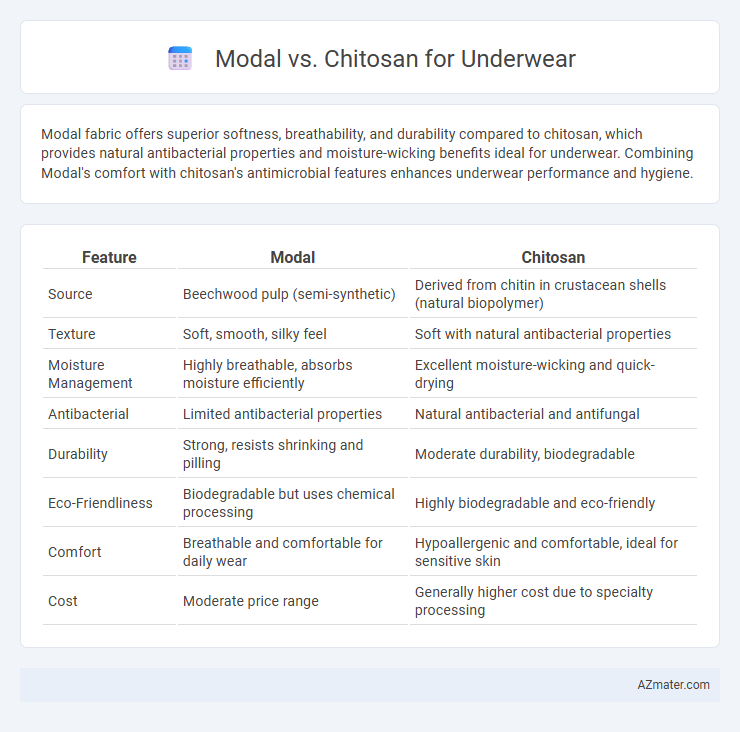Modal fabric offers superior softness, breathability, and durability compared to chitosan, which provides natural antibacterial properties and moisture-wicking benefits ideal for underwear. Combining Modal's comfort with chitosan's antimicrobial features enhances underwear performance and hygiene.
Table of Comparison
| Feature | Modal | Chitosan |
|---|---|---|
| Source | Beechwood pulp (semi-synthetic) | Derived from chitin in crustacean shells (natural biopolymer) |
| Texture | Soft, smooth, silky feel | Soft with natural antibacterial properties |
| Moisture Management | Highly breathable, absorbs moisture efficiently | Excellent moisture-wicking and quick-drying |
| Antibacterial | Limited antibacterial properties | Natural antibacterial and antifungal |
| Durability | Strong, resists shrinking and pilling | Moderate durability, biodegradable |
| Eco-Friendliness | Biodegradable but uses chemical processing | Highly biodegradable and eco-friendly |
| Comfort | Breathable and comfortable for daily wear | Hypoallergenic and comfortable, ideal for sensitive skin |
| Cost | Moderate price range | Generally higher cost due to specialty processing |
Introduction: Understanding Modal and Chitosan Fabrics
Modal fabric, derived from beech tree pulp, is prized for its softness, breathability, and moisture-wicking properties, making it a popular choice for underwear designed for comfort and durability. Chitosan fabric, created from chitin found in crustacean shells, offers antimicrobial benefits and biodegradability, providing an innovative and eco-friendly alternative for intimate apparel. Understanding the distinct characteristics and benefits of Modal and Chitosan fabrics helps consumers make informed decisions about comfort, sustainability, and functionality in underwear.
What is Modal? Origins and Key Features
Modal is a semi-synthetic fabric derived from beech tree cellulose, known for its exceptional softness, breathability, and moisture-wicking properties. Originating in the 1950s, Modal is produced through a chemical spinning process that enhances its durability and resistance to shrinkage compared to traditional cotton. Key features of Modal include its smooth texture, high absorbency, and eco-friendly production methods, making it a popular choice for comfortable underwear.
What is Chitosan? Properties and Production
Chitosan is a natural polysaccharide derived from chitin, primarily sourced from crustacean shells such as shrimp and crab through a process called deacetylation. It exhibits excellent biodegradability, antimicrobial properties, and high moisture retention, making it an ideal material for enhanced hygiene and comfort in underwear. The unique molecular structure of chitosan enables effective odor control and skin-friendly breathability, setting it apart from conventional fabrics like modal.
Comfort and Breathability: Modal vs Chitosan
Modal fabric offers superior softness and excellent moisture-wicking properties, ensuring high comfort and breathability for underwear. Chitosan, derived from natural biopolymers, provides antimicrobial benefits while maintaining moderate breathability, contributing to freshness throughout wear. When prioritizing comfort and breathability, Modal outperforms Chitosan by delivering smoother texture and enhanced airflow, making it ideal for everyday underwear.
Moisture-Wicking and Odor Control Performance
Modal fabric excels in moisture-wicking due to its superior breathability and quick-dry properties, making it ideal for keeping underwear dry and comfortable. Chitosan, derived from crustacean shells, offers powerful antibacterial and odor control benefits by inhibiting microbial growth on the fabric surface. Combining Modal's moisture management with Chitosan's antimicrobial effects results in underwear that effectively maintains freshness and reduces odor during extended wear.
Antibacterial Benefits: Chitosan in Underwear
Chitosan fibers in underwear provide superior antibacterial properties by inhibiting the growth of bacteria and reducing odor compared to Modal fabric. The natural antimicrobial activity of chitosan effectively prevents infections and promotes skin health, making it ideal for sensitive or allergy-prone skin. Unlike traditional textiles, chitosan-enhanced underwear maintains freshness longer, improving hygiene during extended wear.
Eco-Friendliness and Sustainability Comparison
Modal is a semi-synthetic fiber made from beech tree pulp, valued for its biodegradability and lower water usage compared to conventional cotton, making it an eco-friendly choice for underwear. Chitosan, derived from crustacean shells, offers natural antimicrobial properties and is biodegradable, promoting sustainability by utilizing marine waste and reducing the need for chemical treatments. Both materials support eco-conscious underwear production, with Modal emphasizing renewable forestry resources and water efficiency, while Chitosan enhances sustainability through waste valorization and functional textile benefits.
Durability and Maintenance: Which Lasts Longer?
Chitosan underwear offers superior durability due to its natural antibacterial properties and resistance to wear and tear, making it last longer under frequent use compared to Modal fabric. Modal, a type of rayon made from beech tree pulp, provides softness and breathability but tends to degrade faster with repeated washing, leading to pilling and reduced fabric strength. Proper maintenance of chitosan underwear, including gentle washing and air drying, further extends its lifespan, whereas Modal requires more delicate care to prevent damage and preserve its texture.
Skin Sensitivity and Hypoallergenic Properties
Modal fabric offers superior breathability and moisture-wicking properties, making it ideal for sensitive skin by reducing irritation and preventing bacterial growth. Chitosan, derived from shellfish, provides natural antimicrobial and hypoallergenic benefits, which help in minimizing allergic reactions and enhancing skin comfort. Both materials support skin health, but Modal excels in softness and moisture management, while Chitosan promotes protection against allergens and skin infections.
Choosing the Best Fabric for Your Underwear Needs
Modal fabric offers exceptional softness and moisture-wicking properties, making it ideal for underwear that prioritizes comfort and breathability. Chitosan-infused fabrics provide natural antibacterial benefits and odor resistance, suitable for sensitive skin and extended wear. Selecting the best underwear fabric depends on whether you value softness and moisture management (Modal) or antimicrobial protection and durability (Chitosan).

Infographic: Modal vs Chitosan for Underwear
 azmater.com
azmater.com